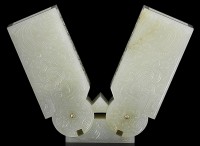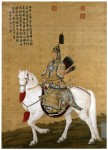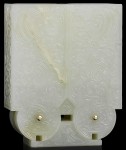 An imperial white jade object from the 18th century that is as mysterious as it is beautiful will be going up for auction at Bonhams next month. Made for the Qianlong Emperor (reigned 1735-1796), sixth emperor of the Qing Dynasty, the piece is made out of two hollowed rectangles that are connected to a central triangle via two hinges. They hinges work, allowing the rectangles to move from laid out straight to fully vertical.
An imperial white jade object from the 18th century that is as mysterious as it is beautiful will be going up for auction at Bonhams next month. Made for the Qianlong Emperor (reigned 1735-1796), sixth emperor of the Qing Dynasty, the piece is made out of two hollowed rectangles that are connected to a central triangle via two hinges. They hinges work, allowing the rectangles to move from laid out straight to fully vertical.
The hinge-fitting embodies much of the artistic and historical pre-occupations of the Qianlong period. Carved from exceptionally fine and lustrous white stone, with even the minor flaws most cleverly incorporated into the scrollwork, the thinly hollowed supremely challenging yet technically flawless piece is representative of the highest skill of the 18th century craftsman. Furthermore it falls into a group of jade pieces carved with the Qianlong fanggu mark, specifically carved with archaistic designs inspired by archaic bronzes to reflect the concerns of the Qianlong Emperor with drawing moral strength and righteousness from the examples of the ancients.

The ancient bronze that inspired this piece was described in the 1751 catalog of the imperial bronzes as a “Han Dynasty ornament,” which means they had little idea what it was for either.
 The Qianlong Emperor was a passionate collector of art. His agents would buy up entire private collections from people who had fallen in hard times or whose descendants didn’t want to be associated with them because they had taken the wrong side during the wars of the Qing Conquest. There are thousands of jade pieces in the imperial collection and almost all of them were acquired or commissioned by the Qianlong Emperor.
The Qianlong Emperor was a passionate collector of art. His agents would buy up entire private collections from people who had fallen in hard times or whose descendants didn’t want to be associated with them because they had taken the wrong side during the wars of the Qing Conquest. There are thousands of jade pieces in the imperial collection and almost all of them were acquired or commissioned by the Qianlong Emperor.
Although he was an artistic polyglot who welcomed the fusion of Chinese and Western styles (the famous bronze animal heads of the Chinese zodiac were made during his reign), the Qianlong Emperor saw himself first and foremost as the keeper of China’s artistic heritage. His collection of ancient bronzes was unparalleled, as was his collection of antique paintings. An incredibly prolific poet in his own right, he adopted a practice of the Song dynasty emperors and inscribed his poems on paintings in the collection.
 That desire to integrate the glorious past of China’s cultural heritage and its glorious present as incarnated by him may be key to identifying the purpose of the hinged jade object. There is another hinged white jade piece similar to this one which is engraved with an imperial poem.
That desire to integrate the glorious past of China’s cultural heritage and its glorious present as incarnated by him may be key to identifying the purpose of the hinged jade object. There is another hinged white jade piece similar to this one which is engraved with an imperial poem.
The poem appears to refer to the jade piece as a ‘ruler’ to be used to ‘compare lengths’ with ‘precisely fitting workmanship’. This pre-occupation with the idea of measuring is also connected to the idea of the benevolent ruler who is guided well.
That’s not to say this was its original purpose. The Han bronze may have had a whole other significance to which the Qianlong Emperor ascribed his own meaning.
The piece is estimated to sell for £200,000 to £300,000 ($333,000 – $500,000), but the market for Chinese antiquities is insane right now so those numbers could go increase geometrically. The auction catalog is not available yet. They’re usually released four weeks before the auction, so if you’d like to leaf through it, check this page the last week in April.
